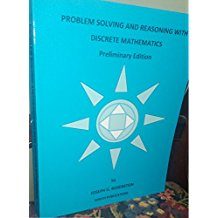Book Review: PROBLEM SOLVING AND REASONING WITH DISCRETE MATHEMATICS by Dr. Joseph G. Rosenstein
US K-12 mathematics has long been dominated by the notion that any legitimate pathway through high school and into college requires passing over Calculus Mountain. It isn’t a real mountain, but it might as well be for those who wish to pursue certain professions, not all of which actually make use of calculus at the graduate or professional school level or indeed in those professions in the field. In particular, medicine, dentistry, veterinary medicine, and other prestigious branches of “the healing arts” make calculus an absolute hurdle for those who wish to qualify for professional training. And the results can be harmful not only to individuals who are thus shut out because they can’t get over Calculus Mountain but to the professions themselves and the public they serve. Few doctors outside of those doing research ever use one lick of calculus outside of their undergraduate education, but only those who can “cut it” for four semesters in college are going to get into the requisite professional schools. And not all those who make it are necessarily the best-suited to be healers; neither are all those who are kept out necessarily otherwise ill-qualified.
The above issues aside, there seems to be a factor of inertia and traditionalism that keeps calculus as the “One True Grail” for school mathematics. And to ask why this need be the only path for our students is to risk being branded a heretic. One person who has challenged the received wisdom is Dr. Joseph G. Rosenstein, an emeritus professor of mathematics at Rutgers University. He’s done so not by attacking analysis, but by offering a major alternative for students in K-12: discrete mathematics. In the introduction to his textbook, PROBLEM SOLVING AND REASONING with DISCRETE MATHEMATICS, he writes that the text, “addresses five types of issues related to problem solving and reasoning: (a) strategies for solving problems, (b) thinking and acting systematically, (c) mathematical reasoning, (d) mathematical modeling, and (e) mathematical practice. Although many of the mathematical topics in this book are not addressed in the current version of the Common Core State Standards, these five types of issues play a major role in what the standards refer to as “Standards for Mathematical Practice.”
Dr. Rosenstein’s textbook offers a coherent treatment of a major strand of mathematics that has many of the most important qualities of both abstract and applied math, including rigorous thinking and proving, utility, and beauty, all of which can be accessible to K-12 students who many not necessarily have been drawn to or successful with every aspect of the traditional curriculum. In these senses, Rosenstein provides a pathway that exemplifies the heart and soul of the Standards for Mathematical Practice, the piece of the Common Core Mathematics Standards that to my thinking exists above and beyond any particular list or sequencing of topics in the Content Standards.
Further, his book is eminently accessible to a broad range of students and teachers. He has selected from the most appealing areas of discrete mathematics, starting with coloring, graphs, counting, and paths and circuits, all of which provide students with the opportunity to dive into serious math and be successful with it. The problems are chosen to be thought-provoking and engaging, with a mix of the concrete, the abstract, the applied, and the esthetic. Teachers who are not themselves deeply familiar with one or more of the topics can readily explore discrete mathematics with students in ways that






![Erratum for “An inverse theorem for the Gowers U^s+1[N]-norm”](https://azmath.info/wp-content/uploads/2024/07/2211-erratum-for-an-inverse-theorem-for-the-gowers-us1n-norm-150x150.jpg)

